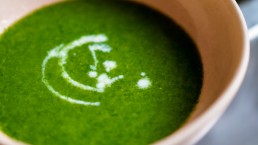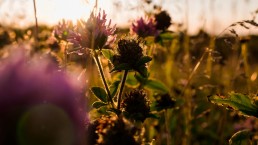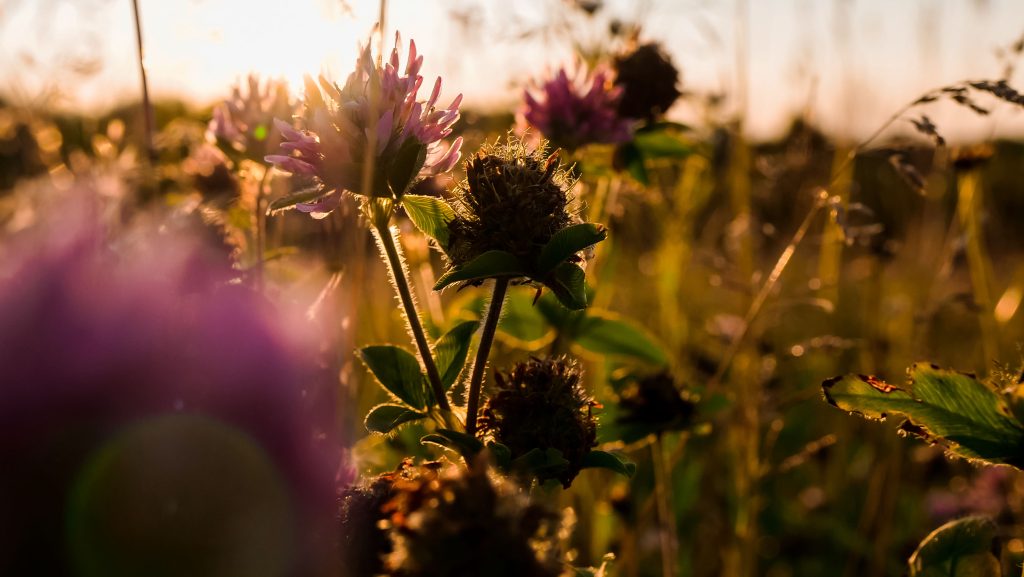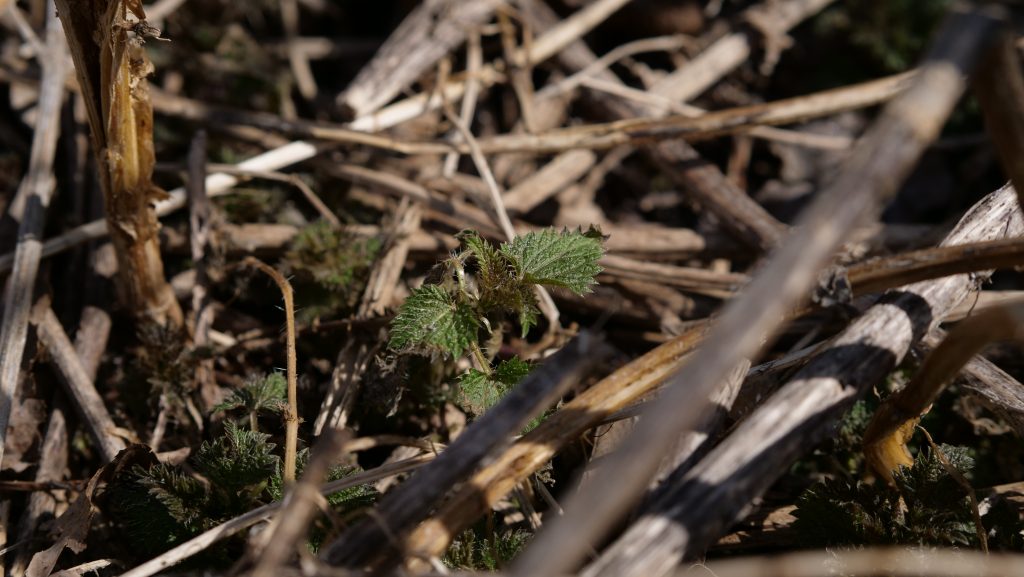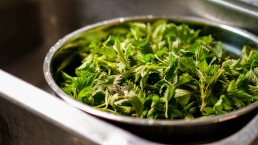Herbal Actions: Alteratives
Herbal Actions
What is a “herbal action”?
When we speak about the action(s) of a certain plant, we are referring to one or more effects a plant can have on our body. Often these actions are explained in two or three words; however, herbal actions are so much more than that! Since plants are wonderful complex beings, they also have several actions. Most herbs can compliment their action(s) in combination with another herb, basically showing off their best side with the support of a “good friend”. Sometimes they work great on their own, but most of the times, they excel with a good buddy on their side. Think- Teamwork!
Alteratives
In this blog post, I would like to have a closer look at the ‘alterative’ action of herbs. After studying my resource books and putting together what I have gathered from my mentors, it turned out to be quite difficult in nailing it down to one definition. What can be found in the next few lines, is a summary of my own attempt to define alteratives. While some herbalists may agree with the words below, others may crunch and frown upon this review. As with all studies, especially herbal studies, learn your craft from many different teachers and find what works best for you.
When I think of alteratives, I immediately think of a tonic action. Tonifying herbs usually slowly, but gradually, alter and support the bodies natural actions and functions. Unlike carminatives for instance, which may help you feel better promptly after a heavy meal has left you feeling full and with an aching stomach, tonic herbs like alteratives take more time to show effects. These effects however, keep one in for the long run and can show beneficial changes in several organs and organ systems. Herbalists once referred to alteratives as ‘blood purifiers’. Nowadays however, most herbalists no longer use this term, as only pure blood can keep one alive and if blood would be poisoned or ‘impure’, our bodies would die.
How Alteratives Work
Alteratives gradually restore proper function of the body, which automatically increases overall health and vitality. By helping to disperse toxic buildup in the interstitial fluid, alteratives aid the body to properly remove toxins and therefore, improve the metabolism, supporting proper absorption and delivery of nutrients and insure healthy elimination. As alteratives are masters of proper elimination, they mainly work on the kidneys, liver, lungs, the lymphatic system and skin.
Many alterative herbs are rich in minerals, vitamins and other trace elements and highly nourishing substances. Furthermore, most alteratives are alkalizing to the blood and help neutralize excess acid in the system. Some work by stimulating digestive function and some are immunomodulators. As stimulants, they mildly stimulate and activate the vital organic functions of the liver and gall bladder.
Personally, I have successfully used alteratives for a variety of instances. I am most excited to share how I was able to effectively clear stubborn eczema on my hands. By its special affinity in supporting organs of elimination, alteratives can help to restore sluggish liver functions. As the master detoxifier, the liver has a wide variety of functions and tasks. If these lack, so does proper elimination, and other organs have to take over the job of a comprised liver. Usually, the lungs, skin, kidneys, liver, colon and lymph share the many tasks of elimination. If one organ works at half capacity, another organ has to pick up the slack. In many cases, it can fall onto the skin, which then may break out with rashes or other skin eruptions. Alteratives are best supported with a holistic treatment protocol, which your herbalist can help you design. This could include dietary, physical, emotional and other lifestyle changes.
It is important to note that initially after starting treatment, skin eruptions can worsen. This is because the skin has already been trying to push these ‘stuck wastes’ out, and with the help of alteratives, now get’s a ‘push’ to finish this task. Therefore, before improvement is seen, initial worsening may happen, usually lasting for only a short period of time.
When to Use Alteratives
When in doubt, use alteratives. As most alteratatives are very gentle and work over a longer period of time, they should be the first group of herbs to consider when working with chronic inflammatory and degenerative diseases. These include skin issues, digestion issues, heat and dryness, cysts, arthritis and autoimmune conditions.
Energetics
As for energetics, many alteratives are bitters. Generally, most bitter plants are drying. In traditional Chinese medicine toxins of the blood and toxin-producing infections are considered ‘excess heat’. Since the Liver is associated with heat, too much heat can create extreme imbalance. Many alteratives are cooling liver herbs.
What are Energetics?
In herbalism we often refer to the “energetics” of plants. This can be a very helpful tool, as we get to not only consider the medicinal action of a plant and a certain condition we are trying to treat, but much more than that, we actually learn to work with the entire ecosystem of both plants and humans/animals. The basic energetics I will be referring to are cold/warm/damp/dry. As an example, if your underlying body condition is usually cold and dry, counter this with warm and damp herbs. This being said, I am not speaking of the actual, measurable temperature of a plant or fruit, but the effect this herb has on the body. As an example, think of biting into a piece of ginger or a cayenne pepper. Hot or cold? How about nibbling on chickweed or biting into a watermelon? Hot or cold?
If this interests you, Matthew Wood’s Book “The Practice of Traditional Western Herbalism” is awesome, or try Jim McDonald’s “Actions and Energetics in Western Herbalism” (available online).
Examples of Some Alterative Herbs
- Arctium lappa (Burdock root) is both preventive and medicinal as it supports the detoxification process. Burdock root assists liver supporting toxin elimination through the skin and bowels. As a bitter, Burdock stimulates the secretion of digestive juices, especially bile. Therefore, it helps with digestion and appetite. Burdock is cooling, as it cools the ‘heat’ of rashes. It is extensively used for the treatment of skin conditions that result in dry and scaly patches. Most effective for psoriasis if used over long period of time. Also great for teenagers with problem skin.
- Taraxacum officinale (Dandelion root and leaf) is similar to Burdock root. Dandelion is useful in signs of a hot inflamed liver with stagnation. It improves liver function and aids the natural detoxification process while protecting liver cells from oxidation and damage. The leaves have clear affinity for the gallbladder and, as such, aid in the digestion of fats. Ideal for those with “sour stomachs”. Great as digestive bitter, cooling to the liver. For chronic inflammation of the liver, it aids proper metabolism, supports detoxification and elimination. It also brings relief in gout and rheumatism as well as glandular swelling.
- Berberis aquifolium, Mahonia spp. (Oregon Grape Root) As a mild alterative, Mahonia is great for use with children as well as the elderly. It has a strong affinity for the liver and supports detoxification and elimination. As a bitter, moistening root that supports secretion of bile from the liver, it shows efficiency in bowel movements. In his book, The Practice of Traditional Western Herbalism, Matthew wood writes that, ‘The typical Mahonia patient is thin, dry, and constipated, with rough, scaly, dry skin.’
- Urtica dioica (Nettles) are considered a ‘blood building herb’ (eczema, headaches) as it tonifies organs and boosts the actions of many organ systems with a special affinity for the urinary tract/kidneys. Nettle is used as a spring tonic and general detoxifying remedy, being an excellent source of nutrition for the weak and feeble, recovering from illness or nursing mothers. Nettles are one of the most nourishing tonic herbs and foods we have in Western herbal medicine. Often times, Nettles are used specifically for childhood eczema and beneficial for all varieties of this condition, especially nervous eczema. Nettles can be helpful as a component of treatment for eczema in adults.
- Trifolium pratense (Red clover) Red clover is said to ‘thin the blood’ and has purification properties often benefitting those suffering with eczema, acne and other skin conditions. It is an important remedy for many childhood ailments and may be used safely for any case of eczema. Red clover is considered in cases of edema and hardened, sore lymph nodes, softening stubborn, hard, encysted lymph nodes. For clearing up cysts in the body, as any alterative, red clover needs to be used over a longer period of time. It has a special affinity to glands around the neck, under the ear and towards the back of the neck, as it tends towards single swollen glands. Check out the doctrine of signatures; The flower head resembles a lymph node. Further, Red clover acts on the liver, protects and aids in detoxification.
I hope this post gave you a little insight on Astringents and how they can interact with our body. This topic is covered much more in depth in the herbal course, which is currently developed and coming soon by our group of wonderful herbalists.
Resources:
Besides my own words, this write up features information from the following resources:
- Jim McDonald – Foundational Herbcraft – www.herbcradft.org – collected writings from www.PlantHealkerMagazine.com.
- David Hoffmann – Medicinal Herbalism: The science and practice of herbal medicine. Healing Art Press, Rochester, Vermont 05767. 2003.
- Abrah Arneson – The Herbal Apprentice: Plant Medicine and the Human Being – Green Heart Press. 2014.
- Matthew Wood – The practice of Traditional Western Herbalism – Basic Doctrine, Energetics and Classification – North Atlantic Books, Berkley, California. 2004.
- Rosemary Gladstar – Herbal Recipes for Vibrant Health – Storey Publishing, 2001/2008
Nettle Seed
Nettle Seed
(Urtica dioica semen)
Etymology
- urtica from the Latin “urere” meaning to burn
- dioica from Latin for “two houses” – this refers to male and female flowers occurring on separate plants.
- Nettle from the Anglo-Saxon word “noedl” meaning “needle”.
In contemporary western herbal medicine, nettle seed is essentially an energizing trophorestorative for the kidneys. Some herbalists also refer to nettle seed as an adaptogen.
Historical Uses
Let’s begin with historical uses.
First Historical use of Nettle Seed:
Nettle seed was part of the feed given to horses that were much loved. It made their coats shiny and they appeared to have more vigor.
This is important because the coat of an animal, or the hair of a human, will tell you a lot about the health of the body from which it sprouts. Hair that lacks lustre and fullness, unless there is male pattern baldness (androgenic alopecia) which is hereditary, suggests the body lacks the nutrients it needs. The body will sacrifice the hair in order to conserve nutrients needed for more necessary functions. If malnutrition is prolonged, changes can also be seen on the nails and skin.
So, we know from those who fed their beloved horses nettle seeds had healthier animals with sustained vigor. We can hypothesize this is because of the nutrients in the seed.
Second Historical non-use of Nettle Seed
Monks during the middle ages, 500 CE to about 1500 CE, were forbidden to take nettle seeds. It was considered an aphrodisiac. They were given Vitex agnus castus seeds instead. This plant suppresses libido in men.
We now know that Nettle seeds awakens the sexual appetite in men. A vigorous sexual appetite suggests gusto for life. This suggests the Nettle seed in some way nourishes the endocrine system. The endocrine system is responsible for survival of the species. It does this by releasing hormones that govern of many of life’s survival actions including inflammation and fever as well as fight, flight and freeze and sex. Sex being essential for the survival of the species.
Nettle Seed, as do most seeds, are high in essential fatty acids. These oils are necessary for a healthy functioning endocrine system which includes both sexual and immune health.
Third Historical use of Nettle Seed
Culpepper, an English herbalist from in the mid 1600s, had many uses for Nettle Seed. From Culpepper’s Complete Herbal…..
The seed provokes urine, and expels the gravel and stone in the reins or bladder, often proved to be effectual in many that have taken it. The same kills the worms in children, eases pains in the sides, and dissolves the windiness in the spleen, as also in the body, although others think it only powerful to provoke venery… The seed being drank, is a remedy against the stinging of venomous creatures, the biting of mad dogs, the poisonous qualities of Hemlock, Henbane, Nightshade, Mandrake, or other such like herbs that stupify or dull the senses; as also the lethargy, especially to use it outwardly, to rub the forehead or temples in the lethargy, and the places stung or bitten with beasts, with a little salt.
From Culpepper we learn about Nettle seed’s direct actions on the kidney. Remember contemporary herbalists now most commonly use it as a kidney trophorestorative. Culpepper tells us it removes kidney stones.
He also suggests it has anti-parasitic actions as well as anti-viral actions. Rabies is a viral infection. This is very interesting to me as I see a lot of infections in my practice and we are currently living with a virus that is changing all our lives.
What Else Can Nettles do for Us?
Constituents of Nettle – not necessarily the seed as most research is done on the leaf – is demonstrating anti-viral activity. For further reading, you can check out this link [here].
One of the primary finding’s researchers noticed when offering nettles as medicine, is the lack of weight loss and vitality when mice were injected with a killing virus. This refers back to those who love horses already knew: Nettles are a super food! And Nettle seed is a super, super food!
The Kidney
Herbal Medicine is the relationship between plants and the body/mind complex. To understand a plant’s medicine, one needs some understanding of the organ or system that the plant effects.
The kidneys are mentioned 5 times in the Hebrew Bible as the organ as God examines to pass judgement on the soul. It is said, Abraham learned the laws of God from dreams offered by his kidneys at night.
“I will bless the Lord, who has given me counsel; my reins also instruct me in the night seasons” (Psalms 16:7).
The ancient Jewish sacred text the Talmudic corpus teaches that one kidney offers good advice, while the other offers bad advice.
In Traditional Chinese Medicine, it is often said that the kidney is where fear resides in the body. The word for fear in Mandarin is Haipa. Haipa is broken into two pictograms; “Hai” which is translated as harm, evil, kill and calamity, and “Pa” which translates into afraid, fear and dread.
Translations of Haipa are; to be scared, to dread, to lose courage, to be unable to endure and to worry.
I find these considerations of the “emotionality” (for lack of better word) of the kidney’s important when we are speaking of Nettle Seed as a kidney trophorestorive. If we consider these ancient understanding of kidneys – a kidney trophorestorative is a plant that restores the courage, resiliency and the power to stand in our creative goodness.
This brings us to the adoptogenic effect of a kidney restorative. Adaptogenic herbs act on the adrenal glands to moderate the body/mind’s response to stress.
Stress is such an overused word today that it has almost lost its significance. “We are all stressed out!” Think of stress as the loss of courage, coming from the French word for a “good heart.” When we lose the good heart of courage, we begin to worry. The worry spirals into fear and soon we are waking every morning with dread in our bellies.
Nettle seed restores the courage to the heart by easing the worry from the kidneys.
A More Physiological Understanding of the Kidney.
The kidney controls the tension or relaxation in the heart and all the blood vessels and therefore the delivery of blood carrying nutrients and oxygen to the rest of the body – including the brain. Relaxed, but not too relaxed, circulation means every cell in the body receives the nutrients it needs to be vibrant and healthy. Tension in the kidney has a influence on every cell in the body. Worry creates tension!
The kidney also filters blood. In a cadaver antonym class, squeeze a kidney and it’s like a sponge releasing fluid. The kidney filters the by-products of metabolism, particularly protein metabolism and maintains electrolyte balance. If the kidneys are hindered in their ability to filter the by-products of metabolism, the skin takes on the role. This is why people on dialysis often have the smell of urea coming from skin. Their skin is doing the work on the kidney (back to those horses).
Electrolytes balance the fluid levels in your blood plasma, interstitial tissue and within your cells. Electrolytes maintain the pH balance of your body and enable the contraction of your muscles including your heart and arteries and participate in transmission of nerve signals.
Your kidney’s actions touch every part of your body and can have a profound impact on your mental well being as well. When you take a kidney trophorestorative, you are supporting not just your kidneys but your whole body.
Signs and Symptoms That it’s Time to Take Nettle Seed
- Mid and low back ache when standing. It feels like fatigue in your back. (This, for me, is the key indication that Nettle seed is needed.)
- Dread and fatigue in the morning upon waking. This fatigue can pause once you up and getting on with your day, or it may remain if it has moved deeper into your beingness.
- Aching legs worse with cold.
- Water retention, swollen tongue.
- Low libido.
- Sighing.
When Not to Take Nettle Seed?
- When someone is completely depleted. Nettle seed carries a lot of energy. If someone does not have inner reserves, you may want to begin with Nettle leaf and as the person re-energizes introduce Nettle Seed.
Dosing
Start low and go slow. It is very invigorating and can interrupt a delicate sleep pattern if take too late in the day.
More recourses on Nettle Seed:
- https://www.researchgate.net/publication/242275567_Urtica_semen_reduces_serum_creatinine_levels – Johnathan Treasure’s research into Nettle Seed credited with awakening the current interest in the plant.
- http://ravensongseeds.com/blog-post/nettle-seed-season – This is a fantastic article with harvesting tips and recipes and much more.
- https://napiers.net/blogs/news/nettle-seed-uses – Some curious clinical applications of the Nettle seeds. One needs to check the resources though.
Cooking with Herbs: Stinging Nettle Soup
Recipe
- 1 lb/450 g or more of Stinging Nettles (young tender shoots preferably harvested in early spring)
- 1 tsp salt
- 1 tbsp olive oil
- 1 onion
- 1/2 cup uncooked basmati rice
- 8 cups vegetable broth stock (or use 2 organic vegetable bouillon cubes)
- More salt and pepper to taste
- Garnish: cashew nut cream or regular cream (optional)
Method
1) Wearing latex/rubber gloves sort out the harvested stinging nettles and remove any thick stems.

2) Wash the stinging nettles and drain.
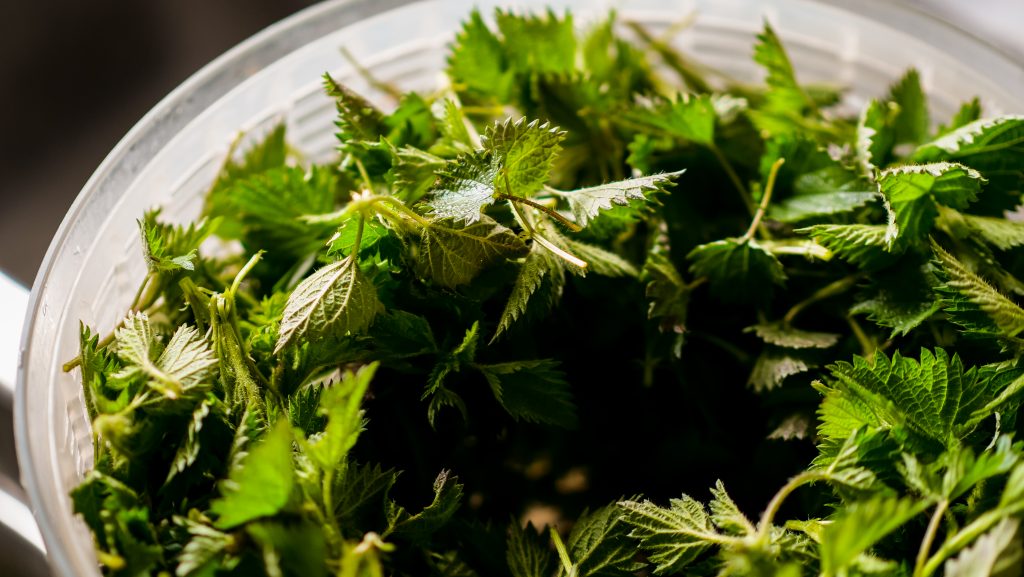
3) Bring a large pot of water to a boil with 1 tsp of salt added. Blanch the stinging nettles in the boiling water for about 2 minutes. This will remove the sting so you can chop it.
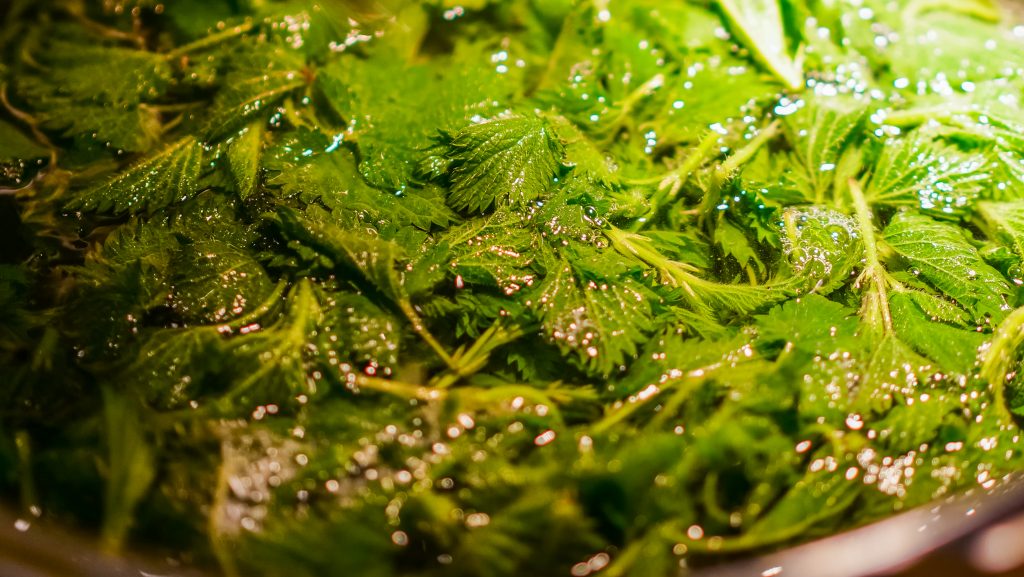
Use a large spoon strainer to remove nettles from the pot. Put them in a colander and run cold water over it to cool it down.
Do not drain the nettle water, reserve it to make your vegetable stock broth.
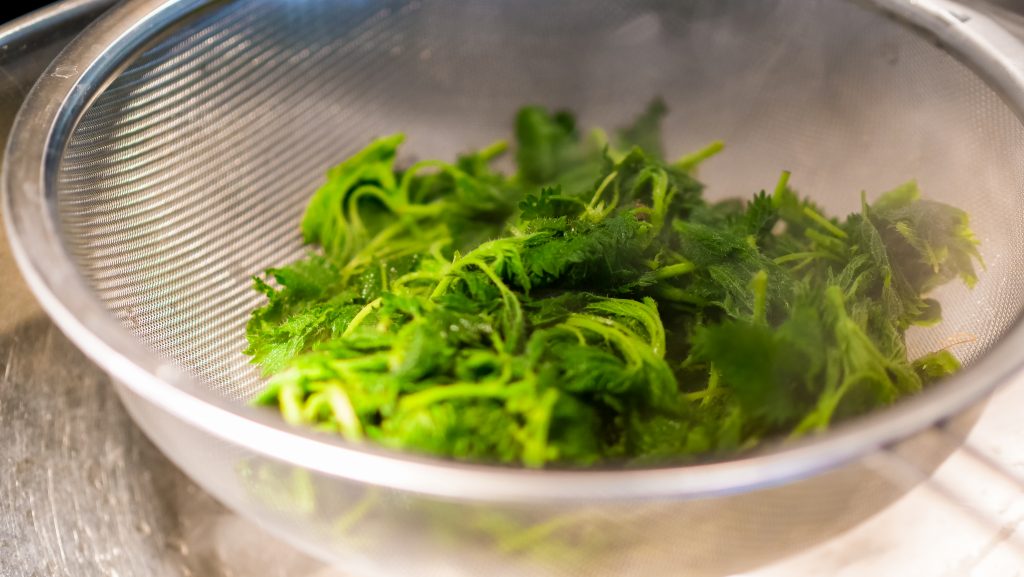
4) Fry a chopped onion in the pot. Add the reserved nettle water along with two stock cubes.
Bring to a boil and add the rinsed basmati rice. Always rinse your basmati rice a few times with water until the water is clear.
Add rice to the pot and simmer for 8-10 minutes.
5) Now add the chopped stinging nettles. Simmer for about 5 minutes, do not overcook this nutritious pot herb. Add ground black pepper to taste. You may not need to add more salt.
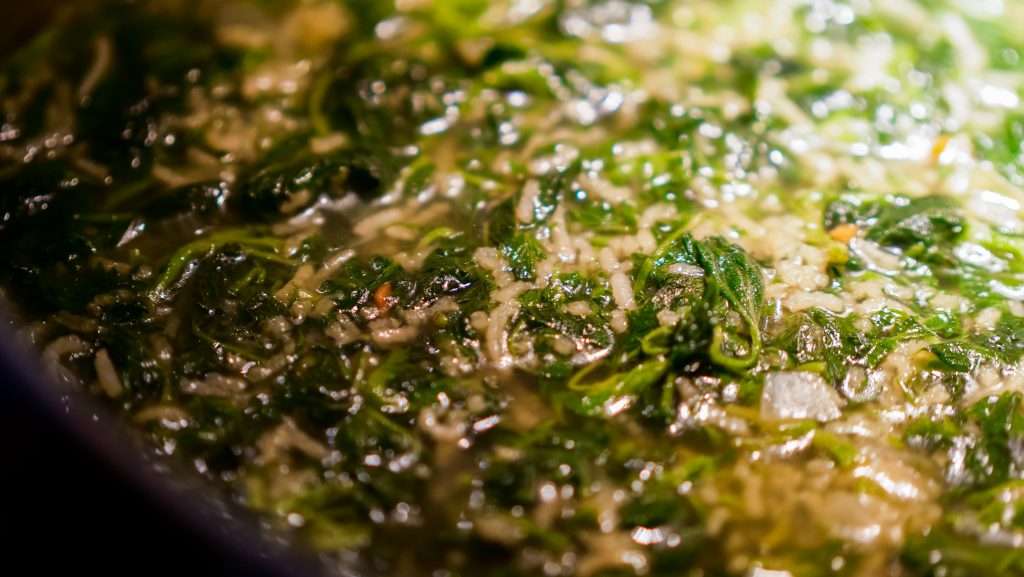
6) Turn off the heat. Using an immersion blender puree the soup. You can enjoy this soup with or without cream served in the bowl.
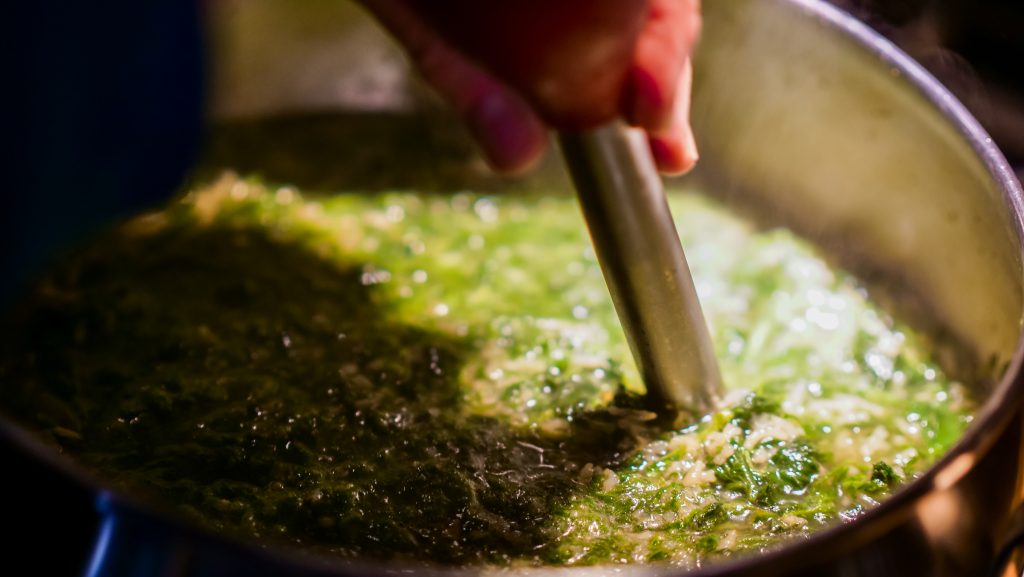
Enjoy!
– Recipe contributed by Karin M
Did You Know?
- The botanical name for Stinging Nettle is Urtica Diocia
- Nettles are a Nutritive (a class of plants that are rich in vitamins and minerals; a source of easily assimilated nutrients. Ideal for those suffering with anemia.)
- Cooked nettles are both salty and sweet. The stronger, salty flavor indicates the high level of minerals and the sweet flavor encompasses elements that build up tissues and strengthen the body.
